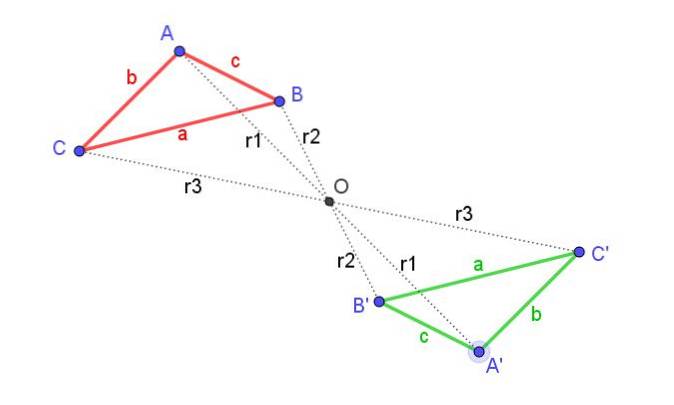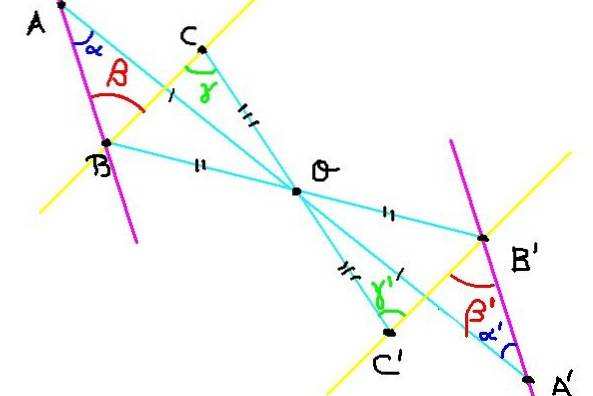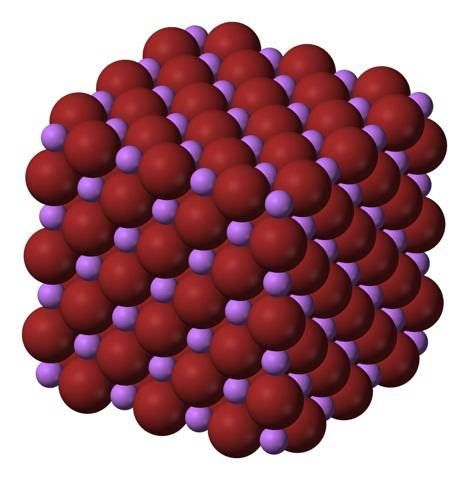
Central symmetry properties, examples and exercises
Two points A and A 'have central symmetry with respect to a point O when the segment AA 'passes through it and is also the midpoint of AA'. Point O is called center of symmetry.
The central symmetric of a triangle ABC with respect to a point O, is another triangle A'B'C 'that has the following characteristics:
-Homologous segments are of equal length
-Their corresponding angles have the same measure.

In figure 1 you can see a triangle ABC (red) and its central symmetric A'B'C '(green), with respect to the center of symmetry O.
In this same figure, an attentive observer would realize that the same result is obtained by applying a rotation of the original triangle, as long as it is 180º and is centered in O.
Therefore, a central symmetry is equivalent to a 180º turn with respect to the center of symmetry.
Article index
- 1 Properties of central symmetry
- 2 Examples
- 2.1 Example 1
- 2.2 Example 2
- 3 Solved exercises
- 3.1 - Exercise 1
- 3.2 - Exercise 2
- 4 References
Properties of central symmetry
A central symmetry has the following properties:
-The center of symmetry is the midpoint of the segment that joins a point with its symmetric.
-A symmetric point of another that is located in the center of symmetry, coincides with the center of symmetry.
-The central symmetric of a triangle is a triangle congruent (equal) to the original.
-The image by central symmetry of a circle is another circle of equal radius.
-A circle has central symmetry about its own center.

-The ellipse has central symmetry about its center.
-A segment has central symmetry about its midpoint.
-The equilateral triangle does not have central symmetry with respect to its center, because its symmetry, although congruent to the first, gives a rotated equilateral triangle.
-Squares have central symmetry about their center.
-A pentagon lacks central symmetry about its center.
-Regular polygons have central symmetry when they have an even number of sides.
Examples
Symmetry criteria have many applications in science and engineering. Central symmetry is present in nature, for example ice crystals and cobwebs have this kind of symmetry.
Furthermore, many problems are easily solved when the existence of central symmetry and other kinds of symmetry is taken advantage of. Therefore, it is convenient to quickly identify when it occurs.

Example 1
Given a point P of coordinates (a, b), we must find the coordinates of its symmetric P 'with respect to the origin O of coordinates (0, 0).
The first thing is to construct the point P ', for which a line is drawn that passes through the origin O and through the point P. The equation of said line is y = (b / a) x.
Now let's call (a ', b') the coordinates of the symmetric point P '. The point P 'must lie on the line that passes through O and therefore it is true: b' = (b / a) a '. In addition, the distance OP must be equal to OP ', which in analytical form is written like this:
√ (totwo + btwo) = √ (a 'two + b 'two )
The following is to substitute b '= [(b / a) .a'] in the above expression and square both sides of the equality to eliminate the square root: (atwo + btwo) = [a 'two + (btwo/totwo).to'two]
By extracting common factor and simplifying, we get that a 'two = atwo. This equation has two real solutions: a '= + a or a' = -a.
To get b ', we use again b' = (b / a) a '. If the positive solution of a 'is substituted, it follows that b' = b. And when the negative solution is substituted, then b '= -b.
The positive solution gives for P 'the same point P, so it is discarded. The negative solution definitely gives the coordinates of the symmetric point:
P ': (-a, -b)
Example 2
It is required to show that a segment AB and its central symmetric A'B 'have the same length.
Starting with the coordinates of point A, which are (Ax, Ay) and those of point B: (Bx, By), the length of segment AB is given by:
d (AB) = √ ((Bx - Ax)two + (By - Ay)two )
By analogy, the symmetric segment A'B 'will have length given by:
d (A'B ') = √ ((Bx' - Ax ')two + (By '- Ay')two )
The coordinates of the symmetric point A 'are Ax' = -Ax and Ay '= -Ay. Similarly those of B 'are Bx' = -Bx and By '= -By. If these coordinates are substituted in the equation for the distance d (A'B ') we have:
d (A'B ') = √ ((-Bx + Ax)two + (-By + Ay)two) which is equivalent to:
√ ((Bx - Ax)two + (By - Ay)two) = d (AB)
Thus being shown that both segments have the same length.
Solved exercises
- Exercise 1
Show analytically that the central symmetric O of a circle of radius R and center O is the same original circle.
Solution
The equation of a circle with radius R and center O (0,0) is:
xtwo + Ytwo = Rtwo (Equation of the circumference C)
If at each point P of the circumference y of coordinates (x, y) its symmetric P 'of coordinates (x', y ') is found, the equation of the symmetric circumference is:
x 'two + Y'two = Rtwo (Equation of the symmetric circle C ')
Now we refer to the result of example 1, in which it is concluded that the coordinates of a point P ', symmetric to P and with coordinates (a, b), is (-a, -b).
But in this exercise, point P has coordinates (x, y), so its symmetric P 'will have coordinates x' = -x and y '= -y. Substituting this in the equation of the symmetric circle we have:
(-x)two + (-Y)two = Rtwo
Which is equivalent to: xtwo+ Ytwo = Rtwo, concluding that the central symmetric of a circle with respect to its center is the circumference itself.
- Exercise 2
Show geometrically that central symmetry preserves angles.
Solution

There are three points A, B and C on the plane. Its symmetrics A ', B' and C 'are constructed with respect to the center of symmetry O, as shown in figure 4.
Now we have to show that the angle ∡ABC = β has the same measure as the angle ∡A'B'C '= β'.
Since C and C 'are symmetric, then OC = OC'. Similarly OB = OB 'and OA = OA'. On the other hand, the angle ∡BOC = ∡B'OC 'because they are opposed by the vertex.
Then the triangles BOC and B'OC 'are congruent because they have an equal angle between two equal sides.
Since BOC is congruent to B'OC 'then the angles γ Y γ ' They are equal. But these angles, in addition to meeting γ = γ ' are internal alternates between lines BC and B'C 'which implies that line BC is parallel to B'C'.
Similarly BOA is congruent to B'OA 'from which it follows that α = α ' . But α Y α ' are alternate interior angles between lines BA and B'A ', from which it is concluded that line BA is parallel to B'A'.
Since the angle ∡ABC = β has its sides parallel with the angle ∡A'B'C '= β' and also both are acute, it is concluded that:
∡ABC = ∡A'B'C '= β = β'
Proving in this way, that the central symmetry conserves the measure of the angles.
References
- Baldor, J. A. 1973. Plane and Space Geometry. Central American Cultural.
- Mathematical laws and formulas. Angle measurement systems. Recovered from: ingemecanica.com.
- Wentworth, G. Plane Geometry. Recovered from: gutenberg.org.
- Wikipedia. Central symmetry. Recovered from: es.wikipedia.com
- Wikipedia. Conveyor. Recovered from: es.wikipedia.com
- Zapata F. Conjugate internal and external angles. Recovered from: lifeder.com



Yet No Comments